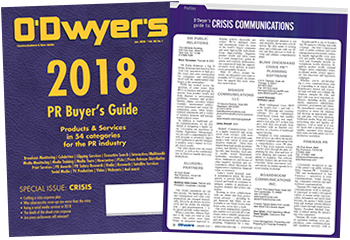|
|
We’re living in the age of the attorney. As each sensational allegation of harassment emerges, corporate legal teams are mobilized to update and strengthen existing anti-harassment policies. Every smart business has such a policy embedded in its employee manual, and especially now, the really smart ones are reassessing and testing that language while directing their lawyers to create more detailed and specific expressions of corporate position, reporting protocols and disciplinary actions.
This should be the age of the communications pro. It would be interesting to know how many of these same companies devote an equivalent amount of time to creation of a crisis communication policy. Our experience suggests the answer is not so many.
|
|
It’s well established that crisis planning typically considers myriad contingencies that may assail corporate reputation. Corporate communicators routinely take the time to delineate a plan of action for as many such scenarios as possible.
Of course, the one you plan for is rarely the one that happens. When the plan doesn’t account for a specific situation, senior leadership and communicators are left to determine, as the crisis unfolds, what they need to do. They study some pre-written step-wise procedure for a close approximation of the current problem, but lack a process for the kind of careful consideration and decision making that needs to take place under pressure.
A framework for action
A solid crisis communication policy begins with a determination of what constitutes a crisis for each specific enterprise. The common denominator in every scenario is that the situation currently or has the near-term potential to distract management from a business’ daily operations. By that standard, what constitutes a crisis comes into sharper focus so that thoughtful consideration of what to do can occur.
Still, the professionals responsible for determining action often lack a framework for engagement even before they determine the actions required. That framework is the corporate crisis communication policy.
A principled approach
When an organization is brought unexpectedly and negatively to public attention, it must be prepared to act in alignment with a set of guiding principles rather than a checklist of tactics. One overarching goal should steer the development of these principles — to sustain or restore the relationship of trust that exists with employees, customers, communities and stakeholders on which our reputation and success depend.
If trust is the goal, then guiding principles might include:
• Delivering information promptly and accurately.
• Acting responsibly in adherence to ethical standards in our response and all communication about the situation.
• Expressing empathy and compassion for those affected by the situation.
• Utilizing the most appropriate channels to ensure communications with key publics occurs as quickly as possible even if only to express that the organization is engaged in situation assessment, response and management.
• Delivering information truthfully in every situation, but also emphatically to ensure the organization’s perspective is understood and its voice is heard even as the situation is unfolding.
Today, it’s generally accepted that prompt, clear, and highly visible communication not only is needed in a crisis, but is expected. Perhaps as a result, crisis communication no longer is about image, it’s about integrity. As such, the old rules no longer apply.
This reality frames a fresh consideration of principles as a central element of any well-conceived crisis communications policy and plan. The growing imperative for forthright communication in crisis circumstances precipitates an impulse to “get out in front,” “release the bad news fast and put it behind you,” “apologize and move on.” Such guidelines for thinking simply don’t work and usually make the situation worse.
Principles guide action
If, as we always recommend, a crisis core team has been created, members usually convene with two immediate questions: “What’s happened?” and “What are we going to do about it?” If, instead, the team begins by reaffirming consensus around a previously considered set of principles and values, then any response actions can be evaluated within a context that crystalizes decision making. Central questions can be used to evaluate every potential action:
• Does this conform with our principles?
• Does it demonstrate responsible management action?
• Does it reflect our concern for those affected?
• Is it consistent with our prior statements and actions and does that matter?
This core team, comprised not only of communicators, but various key operational personnel: security, human resources, customer care. Legal, among others, can then prepare and present its recommendations to leadership with a measure of confidence that it has been careful and not precipitous in the creation of the action plan.
Finalizing the plan
The frequency of crises and the hyper-scrutiny incidents are accorded by the media and others combine to create a harsh environment for communicators and senior leadership.
Operating under duress and making decisions in a hurry, strains everyone’s ability to function. Urgency creates a tendency to act first and think later. Establishing a set of guiding principles that articulate a company’s approach to communication ensures that as the team considers response strategies, actions are in alignment with corporate values.
Advance planning also is greatly improved. Principles facilitate consideration of how the core team will function, who will be engaged and how final decisions will be authorized. Such procedures can then be applied to any contingency. The value of this process is that it completes a great deal of initial leg work for anticipatable scenarios. The core team can assemble best practices, assess their applicability to the specific organizational environment, and test ideas, language and processes that might be utilized.
It’s unlikely an organization can operate for extended periods without difficult situations challenging their ability to go about the daily routine. Treating every such incident as a genuine crisis exhausts the human resources of the company and likely contributes to resistance at the operational level to comply with communication recommendations. Knowing there’s a principled and responsible structure and system for crisis management can instill confidence that any situation can be addressed with the organizational reputation intact.
***
Peter V. Stanton is CEO of Stanton Communications, Inc.

 Peter V. Stanton
Peter V. Stanton 

 There’s a fine line between newsjacking and taking advantage, aka ambulance chasing. Our job as PR professionals is to tread it carefully.
There’s a fine line between newsjacking and taking advantage, aka ambulance chasing. Our job as PR professionals is to tread it carefully. PR firms need to be mindful of ways their work product may be protected by the attorney-client privilege whenever working with a client’s internal legal team or its external legal counsel.
PR firms need to be mindful of ways their work product may be protected by the attorney-client privilege whenever working with a client’s internal legal team or its external legal counsel. Manuel Rocha, former US ambassador and intenational business advisor to LLYC, plans to plead guilty to charges that he was a secret agent for Cuba.
Manuel Rocha, former US ambassador and intenational business advisor to LLYC, plans to plead guilty to charges that he was a secret agent for Cuba. CEO mentoring is an often-overlooked aspect of why CEOs are able to make good decisions, and sometimes make bad ones—all of which intersects with the role and duties of a board.
CEO mentoring is an often-overlooked aspect of why CEOs are able to make good decisions, and sometimes make bad ones—all of which intersects with the role and duties of a board.  How organizations can anticipate, prepare and respond to crises in an increasingly complex world where a convergent landscape of global challenges, threats and risks seem to arrive at an unrelenting pace.
How organizations can anticipate, prepare and respond to crises in an increasingly complex world where a convergent landscape of global challenges, threats and risks seem to arrive at an unrelenting pace.


 Have a comment? Send it to
Have a comment? Send it to 
No comments have been submitted for this story yet.